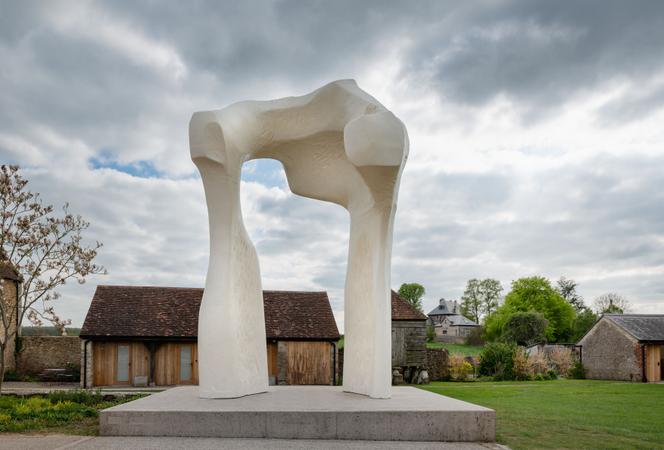
Planted in the middle of the countryside, Stonehenge is one of those places which makes you simultaneously feel a sense of terrestrial power and human genius. Dotted with standing and hanging monoliths, it is a place where space and time resonate. They are connected to the nebulous prehistoric past of man, and to the stars, through the monoliths’ positioning, thought to correspond to the axis of light at the winter solstice. Henry Moore (1898-1986) realized this resonance and came to explore this neolithic site in 1921, when he was a student at the Royal College of Art, in London. At the time, Stonehenge was a popular sensation, fueled by archaeological excavations and discoveries. He was 23 years old and his first visit took place in the moonlight.
A hundred years later or so, an exhibition organized with the Henry Moore Foundation has found a bucolic setting, around 50 kilometers from the site, at Hauser & Wirth Somerset, one of the 15 international branches of the Swiss gallery that specializes in contemporary art and artists' prestigious estates. This summer, the gallery has transformed all the spaces of its chic, rustic Somerset farm, Durslade Farmhouse, into a museum-style exhibition.
Power of evocation
Sharing Form is a vast exhibition designed by Hannah Higham, curator of the Henry Moore Foundation, in collaboration with the artist’s only daughter, Mary Moore. It takes as its starting point, the lasting impact of Stonehenge on the thoughts and experiments of the famous British modernist sculptor. The monumental arch that greets visitors in the farmyard sets the scene emphatically. This milky-white bony form from 1963-1969 is impressive, with its almost surreal power of evocation: it looks like a fusion between the mineral and the organic, halfway between monolithic stone architecture and a giant pelvis. Moving around it reveals how its dynamic contours can create a changing frame, cutting through the space, the sky and the surrounding landscape. There are four versions, two in bronze and one in stone (permanently installed in London's Kensington Gardens). This fiberglass one dominated the artist's historic retrospective in Florence, Italy, in 1972.
These ambiguous forms are more figurative and mechanical than the monoliths, but the way they are grouped, upright like totems, creates a shared vibration that visistors wander through, somewhat reminiscent of the experience at Stonehenge. This is followed by a more direct vision of Mr. Moore's fascination with the intensity of the site, through a series of lithographs. Begun in 1972, he scanned the mysterious "depths and distances" between the masses of ancient stones and their environment, but also explored their texture, day and night, and in all seasons.
You have 40.93% of this article left to read. The rest is for subscribers only.